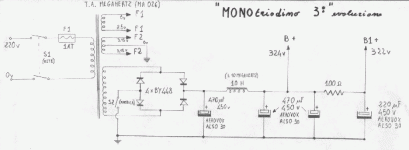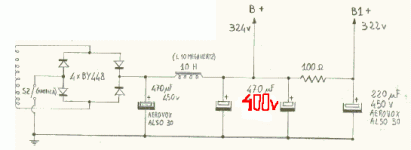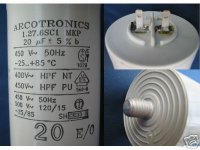Hi...
I've never worked with tupe audio, but as I see it, there's a potential risk for the capacítor located between the bridge rectifier and the inductor. Ripple voltage peaks will be much higher there than after the inductor. Just a consideration. Maybe a computer simulation could solve the mystery.
anyone up for the task?
Jennice.
I've never worked with tupe audio, but as I see it, there's a potential risk for the capacítor located between the bridge rectifier and the inductor. Ripple voltage peaks will be much higher there than after the inductor. Just a consideration. Maybe a computer simulation could solve the mystery.
anyone up for the task?
Jennice.
Is this only an idea or have you practical experience of it?Jennice said:I've never worked with tupe audio, but as I see it, there's a potential risk for the capacítor located between the bridge rectifier and the inductor. Ripple voltage peaks will be much higher there than after the inductor. Just a consideration. Maybe a computer simulation could solve the mystery.
Hi,
I'd suggest you guys fight Viking batlles outside the classroom/forum?
Per-Anders, I know what you mean, but do we have to bite other people's head of?
Please?
Is this only an idea or have you practical experience of it?
I'd suggest you guys fight Viking batlles outside the classroom/forum?
Per-Anders, I know what you mean, but do we have to bite other people's head of?
Please?
cap voltage
Electrolytic capacitors operate best close to their rated voltage. If B+ is no more than 250-260, then 300V caps would be appropo, and perform better than 400-450V caps. If you're worried about post rectifier ripple, use a HV poly after the rectifier, and electrolytics after the inductors.
Electrolytic capacitors operate best close to their rated voltage. If B+ is no more than 250-260, then 300V caps would be appropo, and perform better than 400-450V caps. If you're worried about post rectifier ripple, use a HV poly after the rectifier, and electrolytics after the inductors.
Hi,
Yes...But what about safety margins?
Now do your sims at what cap values really are at operating voltages and feel as smug as you think you are.
Feeling kinda Freddish,
Electrolytic capacitors operate best close to their rated voltage.
Yes...But what about safety margins?
Now do your sims at what cap values really are at operating voltages and feel as smug as you think you are.
Feeling kinda Freddish,
Unlike most other capacitors, electrolytic caps' voltage limit is about heating.
Each 'lytic has a leakage current that rises dramatically beyond it's voltage rating.
In times when big 'lytics were expected to be installed in valve equipment, the manufacturers gave 2 voltage ratings: Normal and Surge.
Normal was for continuous operation, and at this voltage, leakage (and therefore heating) was in the safe area.
Surge was for the period of time when the valves were heating up.
It was known that this time would not exceed 1 minute, therefore the rise in internal temperature known.
It would not be much work to test the leakage of a particular cap (in an enclosed place ), and therefore the temperature rise. This would make for assurance about long term reliability.
), and therefore the temperature rise. This would make for assurance about long term reliability.
 Warning: There are safety issues with electrolytic caps. Apart from the high voltages we deal with on this forum, missused caps can explode. Large caps should always be installed so they would blow into the equipment - not outwards. It's also important to allow space for the cap to blow. No use giving it a 5mm or 1/4" hole to blow through - it'll launch like a Saturn rocket.
Warning: There are safety issues with electrolytic caps. Apart from the high voltages we deal with on this forum, missused caps can explode. Large caps should always be installed so they would blow into the equipment - not outwards. It's also important to allow space for the cap to blow. No use giving it a 5mm or 1/4" hole to blow through - it'll launch like a Saturn rocket.
Each 'lytic has a leakage current that rises dramatically beyond it's voltage rating.
In times when big 'lytics were expected to be installed in valve equipment, the manufacturers gave 2 voltage ratings: Normal and Surge.
Normal was for continuous operation, and at this voltage, leakage (and therefore heating) was in the safe area.
Surge was for the period of time when the valves were heating up.
It was known that this time would not exceed 1 minute, therefore the rise in internal temperature known.
It would not be much work to test the leakage of a particular cap (in an enclosed place
 Warning: There are safety issues with electrolytic caps. Apart from the high voltages we deal with on this forum, missused caps can explode. Large caps should always be installed so they would blow into the equipment - not outwards. It's also important to allow space for the cap to blow. No use giving it a 5mm or 1/4" hole to blow through - it'll launch like a Saturn rocket.
Warning: There are safety issues with electrolytic caps. Apart from the high voltages we deal with on this forum, missused caps can explode. Large caps should always be installed so they would blow into the equipment - not outwards. It's also important to allow space for the cap to blow. No use giving it a 5mm or 1/4" hole to blow through - it'll launch like a Saturn rocket.
Dhaen,
True enough, I don't want to hold an exploding electrolytic in my hands either (I guess I'd miss my hand if I ever tried it!)
(I guess I'd miss my hand if I ever tried it!)
Badman:
As for the best operating voltage of a capacitor, it is true that it stores less energy when operated lower than rated, but what makes them perform "worse" if operated below rated voltage? After all, the stored energy depends on the voltage and capacity; not on the rating alone. Obviously, a 200V / 1000uF can store more energy than a 20 V / 1000uF, but that should be due to the safe operating voltage (rating), as I see it.
However, the ripple voltage when used here as a PSU "storage" capacitor should depend on the ESR & ESL, and the current drawn from a given capacitor, regardles of it's "operating voltage" / "max voltage" ratio.
fdegrove & Per-anders:
As I wrote in my post (if you'd care to read before being rude, P.A.!!) I never worked with this gear, and since operating voltages are much higher than solid-state gear, the ripple voltages will have higher values too.
Jennice
True enough, I don't want to hold an exploding electrolytic in my hands either
Badman:
As for the best operating voltage of a capacitor, it is true that it stores less energy when operated lower than rated, but what makes them perform "worse" if operated below rated voltage? After all, the stored energy depends on the voltage and capacity; not on the rating alone. Obviously, a 200V / 1000uF can store more energy than a 20 V / 1000uF, but that should be due to the safe operating voltage (rating), as I see it.

However, the ripple voltage when used here as a PSU "storage" capacitor should depend on the ESR & ESL, and the current drawn from a given capacitor, regardles of it's "operating voltage" / "max voltage" ratio.
fdegrove & Per-anders:
As I wrote in my post (if you'd care to read before being rude, P.A.!!) I never worked with this gear, and since operating voltages are much higher than solid-state gear, the ripple voltages will have higher values too.
Jennice
fdegrove said:I'd suggest you guys fight Viking batlles outside the classroom/forum?
Per-Anders, I know what you mean, but do we have to bite other people's head of?
Frank I missed the word "than" so I missunderstood the whole thing.Ripple voltage peaks will be much higher there than after the inductor.
Of course ripple voltage will be more before the inductor but still, 260 VAC will give you 367 V and the amp must take at least 5% overvoltage, (better 10%) which gives you 386, or 403V.
I'd say that 400 V is close and to choose 400 V cap you must "know" how good it is. If you don't know anything I think the value _may_ be a bit low.
EDIT: Jennice, sorry I didn't mean to be rude.
EDIT2: Safety
 This is even more important at high voltage, as pointed out above.
This is even more important at high voltage, as pointed out above.Hi,
Those problems are not going to occur under any normal operating conditions.
If you change the cap(s) after the choke, you should also change the last one to 400V.
What you have is a CLCRC filter PS and with the full wave bridge ahead of it the maximum voltage you have there will be:
260 * 1.4 = 364 V.
So, keeping the 450V cap as the first filter cap is wise, after that 400V caps are best as it maximises capacitance and it still leave you with a fair safety margin under no- load conditions.
Hope that clarifies it,
Would this solve any possible problems of voltage-overload on caps in such PSU?
Those problems are not going to occur under any normal operating conditions.
If you change the cap(s) after the choke, you should also change the last one to 400V.
What you have is a CLCRC filter PS and with the full wave bridge ahead of it the maximum voltage you have there will be:
260 * 1.4 = 364 V.
So, keeping the 450V cap as the first filter cap is wise, after that 400V caps are best as it maximises capacitance and it still leave you with a fair safety margin under no- load conditions.
Hope that clarifies it,
mad_z said:I don't have data of this power transformer but secondary for B+ are at about 250-260V.
Any help?
Oops! I should have reviewed the given info more carefully- I just saw 250-260V B+ instead of seeing that the secondary would be that...

fdegrove said:Hi,
Yes...But what about safety margins?
Now do your sims at what cap values really are at operating voltages and feel as smug as you think you are.
Feeling kinda Freddish,
I don't recall being smug. If I were, I wouldn't point out my own goof. Sorry to be unclear MadZ, 400V caps are fully appropo. I was looking at is as if you were using little more than half your available energy storage on the caps (260/450) which would be a silly way to do it. If you really wanna go nuts.... try all poly caps for the PS.... Solen makes some that are appropo, and if you can deal with the funny layout of axial parts, www.apexjr.com has some lovelies VERY cheap.
Hi,
Badman,
Don't take it personal, it wasn't directed at anyone in particular...
It just amazes me from time to time how such a simple question can end up so misread, hence my little jest about it.
Going polyprop all the way would be nice, there's the Solens and also the ASC which I personally prefer.
Either way it's not exactly cheap but well worth it IMHO.
Cheers,
I don't recall being smug. If I were, I wouldn't point out my own goof.
Badman,
Don't take it personal, it wasn't directed at anyone in particular...
It just amazes me from time to time how such a simple question can end up so misread, hence my little jest about it.
Going polyprop all the way would be nice, there's the Solens and also the ASC which I personally prefer.
Either way it's not exactly cheap but well worth it IMHO.
Cheers,
- Status
- This old topic is closed. If you want to reopen this topic, contact a moderator using the "Report Post" button.
- Home
- Design & Build
- Parts
- PSU capacitor max.voltage question



